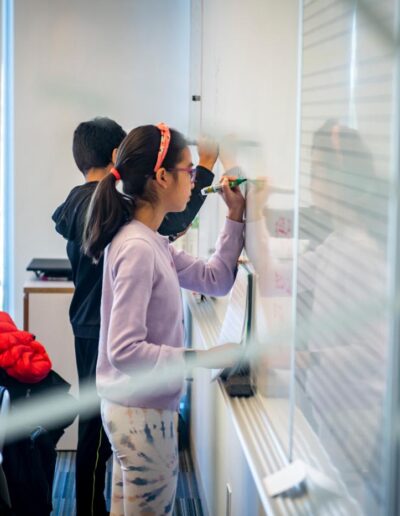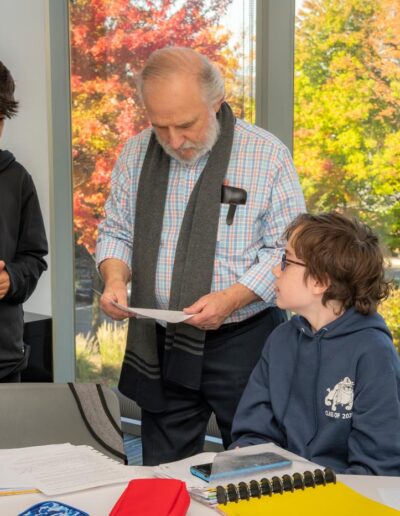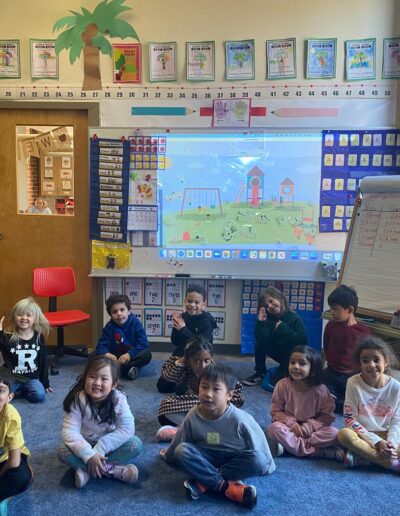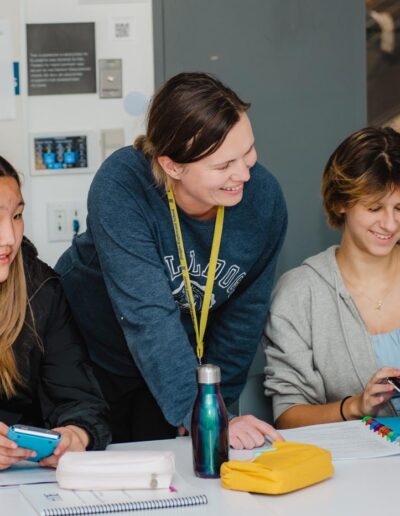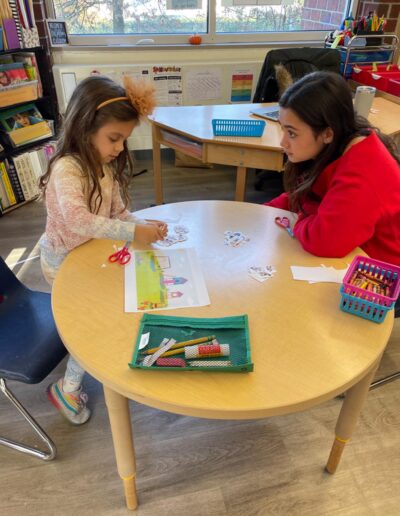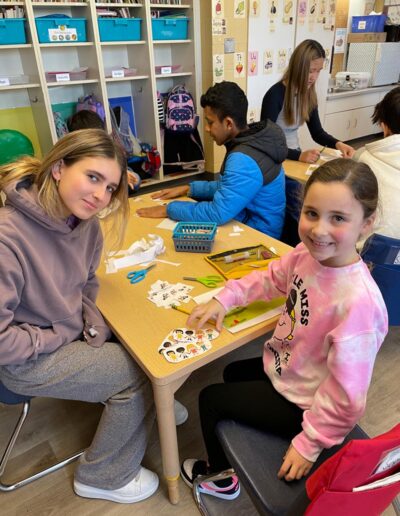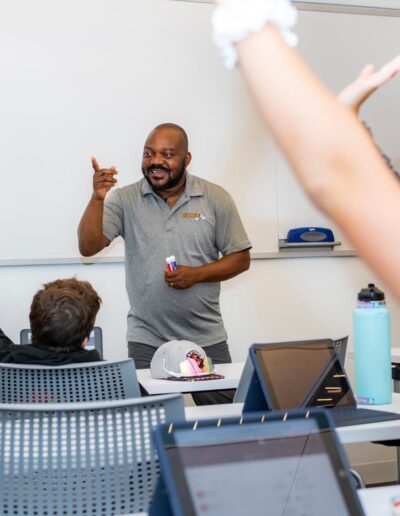What is your primary focus in your role?
Our faculty, regardless of if they teach within the Lower, Middle and/or Upper Schools, are committed to student-based learning, problem-based learning, and student-focused interactions in the classroom. So, my primary focus is to put some structure around that and make sure that we have a continuum from the lower grades up through the high school grade levels, in terms of our educational approach. We’re very intentional about the way that we go from one stage of the curriculum to the next. We aim to give our students not only a smooth experience in general but also build a love of learning through math experiences that are pedagogically- and age-appropriate.
For example, in the Upper School, we’re big into problem-based learning. Our integrated program for the 9th and 10th grades is pretty much all problem-based learning. We wanted to move some of that down into the Middle School because we have middle schoolers who have fairly advanced mathematical thoughts. We thought that they would be able to handle the problem-based approach. However, we have learned that what’s pedagogically age-appropriate for Middle School students is not quite the same as that of Upper School students. So we have introduced problem-based learning into the eighth grade advanced curriculum, but not into the CP curriculum. We feel that while they’re still building their foundational skills, it’s better to have more of a focus on the foundations with the problem-based learning sprinkled in. In seventh grade, we have a lot of foundational work, as well as some problem solving; it’s a mixture in sixth grade as well.
But once students get to the early grades of Upper School (e.g., ninth and tenth grades), all of their math learning revolves around problems and problem sets. The teacher acts as the coach, while students try to solve all the problems at least initially by themselves. They present their work while their classmates comment on whether they did the problems in the same way or a different way. They come to a collective conclusion as to what the answer would be and figure out what are several viable approaches for getting to the answer.
If students don’t know something, whether they lack some foundational skill or don’t know what they need to know in order to solve the problem, then the teacher may jump in. If they’re floundering amongst themselves as to how to approach the problem, the teacher may suggest something to put them back on track, or they may redo a problem in class in small groups in order to make sure that everyone is understanding it. Then there’s some responsibility on the students to reflect in the evening on what they tried.
We want our students to ask questions like: “What did you realize as you were sitting in class from the discussion? What does this process make you think now?”
It’s important that students take notes in their notebooks, so that they’re understanding the problems and asking good questions of their teacher — maybe they realize they need to revisit a problem and can ask for that support the next day. In our problem-based approach, there’s definitely more direction from the students themselves, which is the main developmental reason that we can’t just do that at every age group. When students enter the Upper School, they’re at the right age where they can direct their own learning.
Can you discuss more about how you integrate the curriculum across all three divisions?
In the Lower School, we do a lot of Singapore Math, which mean lots of diagrams and manipulatives to visualize what a ratio or proportion looks like in terms of blocks or lines: something that they draw on a piece of graph paper. This way they are not solely learning the steps to divide fractions as in you flip the second one and multiply them. Instead, they’re learning the process: “if I have this something that’s nine units of ribbon that’s nine yards and I want to give everybody a third of a yard for an art project, how many total pieces do I get?” Rather than just saying: “you take nine and you divide it by a third which means you’re going to multiply it by three over one and get 27,” they’re actually seeing, “Oh, I have nine units. So each one of those nine units is one, but I need a third. So I can get three for each of the one.”
That kind of thinking leads right into what we do in Middle School where they learn a lot more abstract notation like learning what “X” is and then solving for it. Then in the later years in Middle School and the beginning years in Upper School, they learn how to take a problem and regularly ask: “what are all the tools I can use?” You see students even when they get to seventh, eighth, ninth grades, still referring back to those initial diagrams that they drew back in fifth or fourth grades. But you can see that that’s been a part of their mathematical thinking. It becomes part of their toolbox.
What we are talking about is very visual, spatial, and geometric. And, you know, we don’t teach a separate Algebra I, then Geometry and then Algebra II and all of that… because it’s really all the same… it’s Math, right? Geometry isn’t fundamentally a different math. Nor is Algebra. It’s just a different way of looking at things.
And so, we try to start that idea in the Lower School where students look at things from an arithmetic standpoint, as well as from a visual spatial standpoint. And then that turns into looking at something from an algebraic geometry perspective when they start learning those words. And they start understanding abstraction a little bit better.
Data and data collection is another part of our curriculum. In our most advanced sixth grade math class, we asked our students to figure out what the steepest staircase on campus is, to understand slope. They’re going to have to go out and collect data on a staircase. They are going to have to ask: “Well, what do I need to know in order to figure out how steep this is?” This means that first they have to figure out what kind of data are they going to collect. Then, they have to figure out a way to collect that data and a unit to measure it in. Finally they have to figure out once they’ve collected their data, what does it all mean? By modeling the situation in a real way, we can move into ideas of linearity and what slope is.
Our official name for ninth and tenth grade math is Integrated Mathematics and Modeling (IMM). It’s integrated because it’s not just one branch of mathematics. And it’s referred to math and modeling because we do real life data. We may have a theoretical situation where there isn’t actual data that’s been measured, but our students are still going to use a function or a graph or something to model the situation of what’s going on. So we may give them a projectile motion problem where everything’s perfect. We don’t worry about air resistance, friction, etc. But we’re still going to investigate how math applies in real life.
What are the differences from a typical math curriculum in comparison to D-E’s approach?
A typical math curriculum is very much focused on what topics are being covered. Students learn from one topic then jump to another topic and then another topic. Topics usually get increasingly more difficult, but the student generally knows that if they have five problems to do, that all five of those problems are going to relate to a particular subject. Consider the Pythagorean theorem for example. If a student knows the problems given will be about the Pythagorean theorem, they won’t look at a new problem with fresh eyes. The issue is that this is not quite as sophisticated a way of learning. It’s a little bit easier on students. So sometimes students resist a bit because they want to be told what tool to use. And as we all know, that’s not how the world works when you come across a problem in your life. Nobody says to you, “oh, you’re going to apply this [theorum] to solve that problem.”
The first step in our process is always to understand the problem and figure out an approach. We think there’s a huge benefit to kids in their lifelong math learning, as well as life learning in general, to having to do that problem solving activity at the beginning, where they figure out how to try or what to try or if they don’t know what to try, try something. See how it goes. That’s the big difference at D-E. We want our students to ask: “what are the math tools in my toolbox that I have to solve this problem?”
With that said, we have the concepts or threads, to which problems in our curriculum relate. They may relate to more than one topic; there might be an exponential aspect to a problem as well as geometric aspect of a problem, for example. So we do help our students figure out what threads are woven through the curriculum and relate to the problem, so that they can be a bit more enlightened to what tools tend to be employed in which situations. Then they can also say, “Well, you know, I realized that I was using the Pythagorean theorem in this one instance. And then also I saw it in this other instance. And then I saw this other thing with a function that also reminded me of that…”. This way our students get a much deeper and richer experience because they can see threads across problems.
Sometimes when students have come from a different background, and then they come here to D-E, it takes a bit of time to adjust and buy into the idea that this is a good way to learn math.
[At its core] we want all students to feel challenged, enriched and excited in positive ways by the problem-solving approach I’ve described, as opposed to feeling worried, overwhelmed or frustrated. [Our faculty all remain attentive to all of this throughout the process of getting our students more accustomed and comfortable with learning Mathematics through problem solving.]
Within the faculty, how do you (similarly) collaborate with one another and imagine strategies for students’ engagement?
If we just keep talking about the kind of the problem-based IMM curriculum, for example, our teachers obviously have all done the problems before themselves, and they can talk to one another about what occurred for them. There’s an aspect of being able to think about what it’s going to be like for the student before interacting with the students. So that’s one piece where faculty can benefit from bouncing ideas and concepts off each another.
If we have a new faculty member teaching the curriculum then that person would have that relationship with one of the other teachers who’s been doing it longer. But, really, I would say the majority of the conversation and the work among faculty members is more about how to coach for a particular set of problems or threads: what are the questions that we see from students? What are the points of confusion?
[Our work is about] helping the kids to discover the many ways to approach a problem rather than what is the right way, or the best way, or the most efficient way. In some cases, there might be a preferable solution, and in other cases, it’s about appreciating how people can see things differently.
We try to understand what the math looks from the other person’s perspective, then trying to integrate whatever that new topic, idea, process, problem, whatever it is, into what everybody else already knows. So we’re trying to create more experiences that’s then going to make everybody a better problem solver. Even amongst faculty, we’re all kind of all learning all the time. It’s that whole lifelong learning principle that we value here at D-E. And I think in the math and computer science department, we do live by that principle.
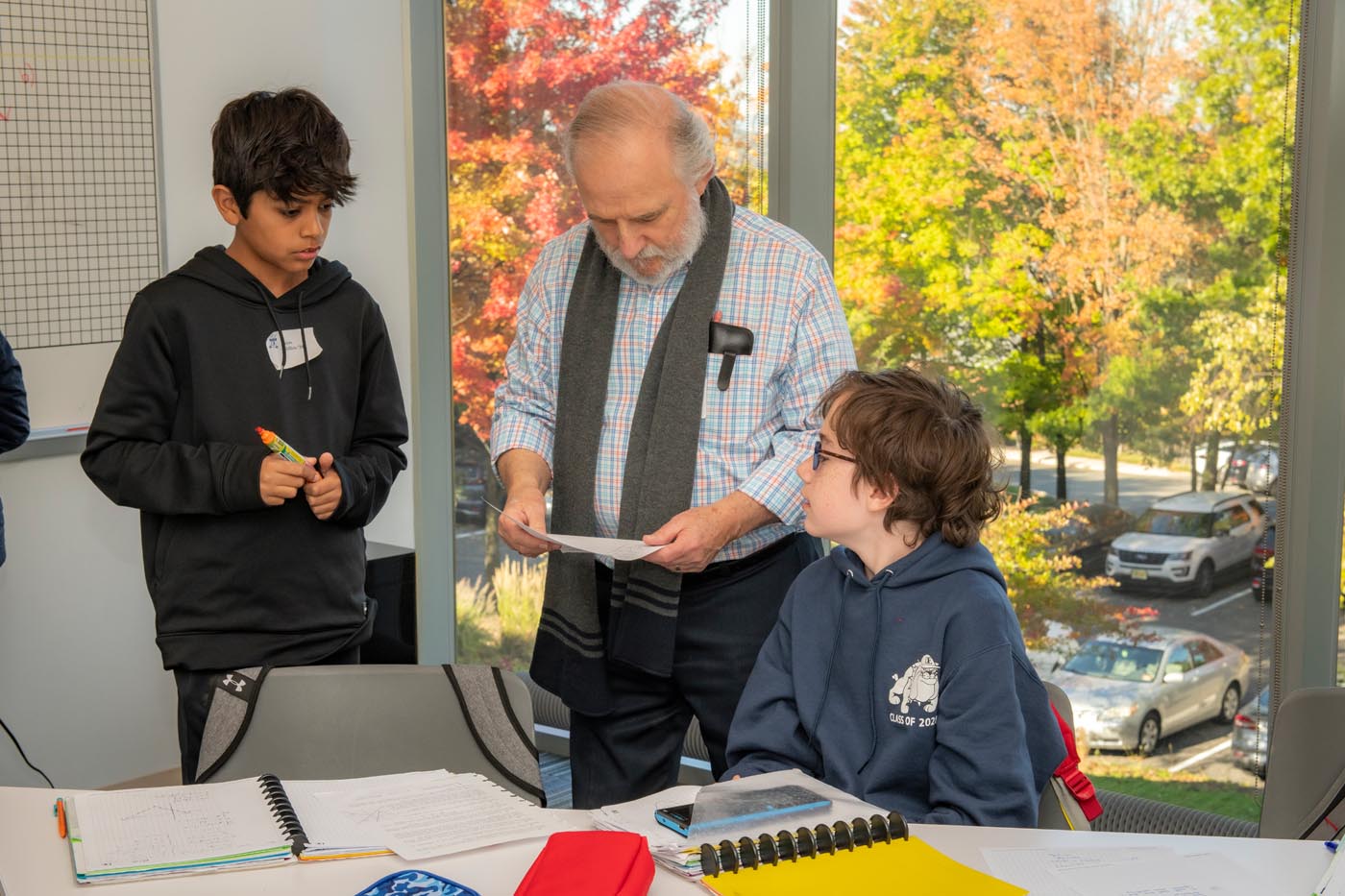
Math is often stereotyped as a disliked subject. With those preconceived notions, how do you build confidence?
[I believe that we build the most confidence in our students through small group work.] In small groups, students realize that they have a contribution that maybe somebody else didn’t think of. I think that just naturally builds confidence. And when you can explain something to somebody else, first of all, you really understand it. And secondly, you can feel good about that! I think a big part of group work and collaboration is simply supporting each other whether students are presenting a problem to the rest of the class or in discussions. We also have periods like Math Lab, Middle School TAG, and office hours to support students in their learning.
What are the opportunities for interdisciplinary learning across departments?
We have two parts of our department: we have the math, and we have the computer science. There is a lot of integration there. Sometimes our best computer science students tend to also be our best math students, but that’s not always the case. A student may have developed a great love for computer programming and all things electronic and because they love gaming, and they want to write games, or whatever, but they haven’t necessarily been particularly interested in learning algebra. And so I think the integration of those two things really provides motivation for those students that might not otherwise be interested in learning math for its owns sake.
We see a lot of integration with engineering classes or robotics, for example. I have previously coached robotics and math, computer science, and physics are all being integrated and utilized. [The heart of robotics is that it’s a problem-based activity:] they’ve got a challenge every year, and they have to figure out, “how am I going to build a robot that accomplishes this challenge?” So that’s a very integrated aspect and the fact that we have the Hajjar STEM Center building makes that possible.
I think there’s a lot of room for a lot more integration, especially in the Middle School. For example, the Middle School has STEM initiatives, five robotics teams, and a physical computing class. The Library houses the Makerspace for students to have more hands-on learning and building, while the Lower School has a STEM specialist. Each division is invested in integrated and inter-disciplinary learning.
How would you like to expand D-E Mathematics Department’s curriculum in the future?
I want to continue expanding upon our elective program. Our department has more people doubling up or tripling up than any of the other departments. You know, we have hundreds of more enrollments than we have students in classes. So that means that the students are taking multiple math and computer science classes. As a result, I think we have a lot of room for introducing more electives for that. Some of our electives are really appealing to kids and some electives are not as appealing. The idea with the elective program is that you would have kids in the same classroom with lots of different experiences. But more typically our students are busy, and they fill up their schedule with all kinds of things. Often, we’ve ended up with an elective program where there tends to be many students that have had a certain math experience at a higher level and then some other electives where there are many students who have kind of been with each other having a different types of math experiences. I want to try to figure out what kind of electives can we offer that will move us back toward that integration. There are also topics like the concept of infinity or fourth and fifth dimensional space where we want to ask what that even means. [I feel that we need to] continually be infusing our program with additional classes.
When students graduate from D-E, what do you hope they leave with?
I hope that our students all feel that they’ve taken ownership of their learning and math learning in particular. I hope that they have internalized and synthesized the math that they’ve learned. I’m less concerned about checking off a whole bunch of topics and rather more interested in whether they think that they know a topic.
For example, in Calculus, I would rather that a student spends more time really understanding what the deep meaning behind a derivative is than have them memorize some formula and then move on to integral calculus. I would rather have them internalize and synthesize and realize the connections across the different types of math as they’re growing.
That often boils down to slowing down. There’s sometimes a mindset from parents and students both that they have to be in this particular advanced level class. I believe that I can speak for all of us in the D-E Mathematics Department that we are more interested in whether students got everything out of the classes they took. [In the end it’s about process, which is what our mission is all about, which talks about love for life-long learning]; we want to encourage iteration and reiteration and that takes patience and time!


